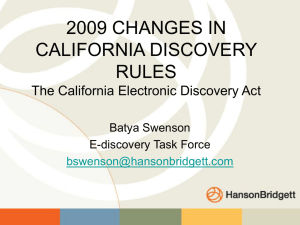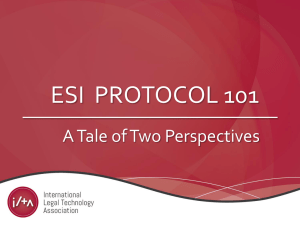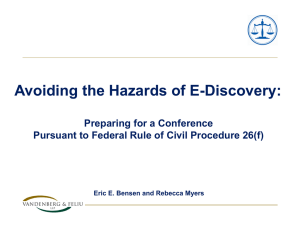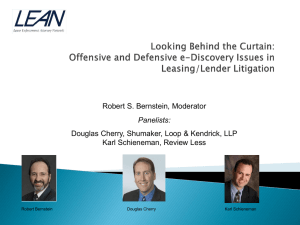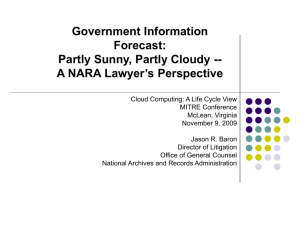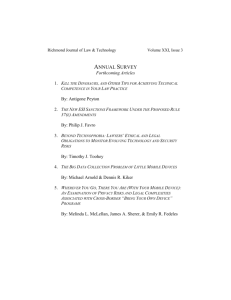Nolasco: e-Discovery
advertisement
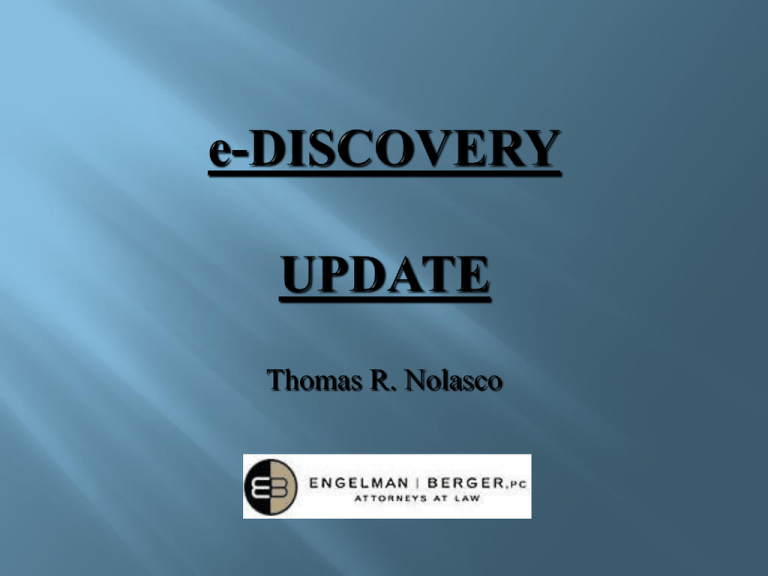
Thomas R. Nolasco Desktop PC Smart phones Thumb drives Laptop USB Storage devices Portable hard drives Tablet Digital cameras iPods/MP3 players Network file servers Digital video recorders Xbox/Game Consoles E-mail servers Digital video cameras Automotive EDRs Legacy systems Paging devices Digital copy machines Routine back-up tapes Digital audio recorders Cloud computing Disaster recovery tapes Voicemail Social media sites Security cameras Medical devices Home appliances ESI Data Paper Data Native format TIFF Sedona Principles De-NIST Metadata Load file Parent-child relation FRE 502 Quick peek Claw back Litigation hold Predictive Coding TAR Zubulake Unallocated space Not reasonably accessible • There is a steep learning curve; • Expect some pushback: o Different, more complex vs paper discovery; “Why do you need to know/have that?” o More Employees may be involved; IT personnel, anyone who sends, receives or maintains relevant ESI “Why do you need to bother them?” o Added expenses and stress for the client; “Why does it cost so much more than before?” • e-Discovery is the “new normal”; o Rules have been in place since 2006 • Courts will impose sanctions on those who resist or ignore e-Discovery rules; • e-Discovery can become “weaponized”, much to your client’s disadvantage. • Before the Rule 16/26 conferences, you need to know what you can commit your client to do! o Timing of ESI disclosures, scope of production, form of production, privilege, privacy, trade secret issues o Consider how e-Discovery can become “weaponized” due to asymmetrical ESI volumes or e-Discovery expertise between the parties • Does client have a document retention policy? o Does the policy account for ESI? (If not, time to update!) o Has it been followed: • Has the client executed a litigation hold before? o How did that work out? o Was the IT staff included • Does client understand its preservation duty? • Courts will hold lawyers and clients jointly accountable for e-Discovery failures • Lawyers are expected to: o Speak with client’s IT staff and “key players” who created, received, sent and store ESI o Understand the client’s system architecture, and o Monitor and confirm their client’s compliance with eDiscovery duties “…counsel must become fully familiar with her client’s document retention policies, as well as the client’s data retention architecture. This will invariably involve speaking with information technology personnel, who can explain system-wide backup procedures and the actual (as opposed to theoretical) implementation of the firm’s recycling policy. It will also involve communicating with the “key players” in the litigation, in order to understand how they stored information.” Zubulake v. UBS, 229 F.R.D. 422 (S.D.N.Y. 2004) • Employees, contractors, consultants controlled by the client who created, received or stored ESI o Anyone who holds relevant, company-controlled ESI Including current and former personnel • Determine what ESI was created, sent, received and stored, including locations and recipients o Be thorough, and document your findings • Expand the litigation hold, as needed • Must be done. Part of counsel’s duty • Obtain written acknowledgements from key players and IT staff and store for later use. • Schedule and implement regular reminders through the life of the case. o To remind existing employees o To inform new employees • Evidence Rule 502 responds to the complaint that litigation costs necessary to protect against waiver of attorney-client privilege or work product have become prohibitive due to the concern that any disclosure (however innocent or minimal) will operate as a subject matter waiver of all protected communications or information. • This concern is especially troubling in cases involving electronic discovery. See, e.g. Hospon v. City of Baltimore, 232 F.R.D. 228, 244 (D. Md. 2005) • Evidence Rule 502 o All e-Discovery plans/agreements should reference it; malpractice otherwise??? o Applies when there is a disclosure of a communication or information covered by attorney-client privilege or workproduct protection; o May limit a privilege waiver, if not avoid it altogether; • Evidence Rule 502(e): • Allows parties to agree that there is no waiver o Agreement alone is binding only on the parties • Incorporating the agreement into a Court order makes it effective as to 3rd parties beyond the agreement o “Clawback” Agreements o “Quick Peek”/”Data Dump” Agreements • Rule 16 scheduling conferences require a discussion of e-Discovery; o Courts expect substantive discussions at ESI issues between counsel; • You Need to prepare for e-Discovery anyway o Rule 26 disclosures (federal) • Possible e-Discovery topics to discuss at the Rule 16 conference: o Limitations on ESI Production? Concept of “proportionality” o o o o o Format of ESI production? Timetable? Scope of e-Discovery? Privilege issues? Shared vendor? Search terms? How many custodians? Cost sharing? Protective Order? Rolling productions? • Assess the client’s ESI situation: o Its prior experience with e-Discovery Novice? Sophisticated? Good? Bad? Sanctions? o What kind of ESI does it keep? How much? o How many custodians may be involved? o How much time will we need to collect, sort and produce it? Will we need to retain an e-Discovery vendor? • If you’re unprepared re ESI, you may: o Unwittingly commit your client to obligations it cannot meet; Possible discovery sanctions…unhappy client; o Cause the “weaponization” of e-Discovery against our client: You may create the appearance of vulnerability; Invite more aggressive e-Discovery tactics; Leading to sanctions, a “coercive” settlement outcome, or worse… • Permits the producing party(s) to forego a privilege review altogether in favor of an agreement to return (“clawback”) inadvertently produced privileged material with no waiver of privilege. • In large volume of ESI cases, it can expedite production and avoid the high cost of a privilege review by the producing party • Allows a party to “pre-produce” documents or ESI prior to reviewing them for privilege without waiving its right to assert applicable privileges. • The requesting party then performs a preliminary relevance review of the produced material, allowing it to tailor its discovery requests. • Producing party can then assert privilege over materials within what was requested. No waiver. • (Old) Minority view: Failure to send a timely legal hold letter is “gross negligence per se”; evidence spoliation is presumed. o Negative inference jury instructions given + possible monetary sanctions + more. • (Current) Majority View: It depends. Sanctions warranted if evidence loss is proven due to lack of a timely legal hold. Sanctions Awarded in e-Discovery Cases 2012 50 40 30 44 20 10 Evidence Preclusion Adverse Inference Monetery 0 14 5 Other 10 Terminating 20 • Common e-Discovery sanctions involve: o o o o o Litigation hold shortcomings Inadequate ESI searches, preservation and collection Lack of supervision by counsel to confirm compliance Lack of cooperation between the parties. Intentional spoilation of evidence • Litigation hold shortcomings: o o o o o o o o Failure to issue one at all Failure to issue one in writing Failure to issue one in a timely manner Failure to issue one to the IT department Failure to issue one to all key players Failure to issue one to all custodians of relevant ESI Failure to verify receipt and compliance by recipients Failure to issue reminders during the course of the case Apple, Inc. v. Samsung Elec. Cos, Ltd., (N.D. Cal. July 25, 2012) • Patent infringement case re smart phones; • Both sides failed to timely implement proper legal hold procedures, resulting in spoliation of evidence; o Didn’t implement legal holds soon enough o Didn’t include all the key players o Didn’t notify the IT department to stop automatically deleting emails • Both sides were sanctions by the Court • Apple won the trial - $900 million verdict Northington v. H & M International (N.D. Ill, January 12, 2011) • Discrimination claims against employer; employer failed to produce relevant documents and e-mails; • Employer’s HR VP only collected documents that were sent to her; ESI data collection was done ad hoc • Court: Employer was “reckless” and “grossly negligent” in failing to initiate legal hold to preserve relevant ESI; • Sanction: Adverse inference jury instruction at trial + attorneys’ fees and costs Science Care, Inc. v. Donna Goyette Maricopa County, Arizona, CV 2009-032397 (March 7, 2011) • Intentional deletion of ESI from laptops by Defendant o “Disk wiping” software used to try to hide deletions o Plaintiff’s computer expert found evidence of wiping software • Court ruling: “Defendant’s conduct cannot, by any stretch of the imagination be characterized as innocent or unintentional.” • Sanctions Imposed: Default Judgment o No sufficient monetary sanctions or adverse inference to cure the prejudice caused by ESI deletion Questions? Thomas R. Nolasco Engelman Berger, P.C. (602) 271-9090 trn@eblawyers.com

